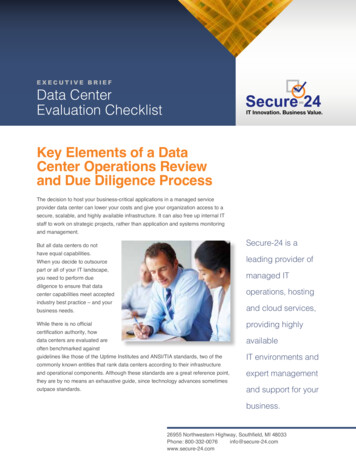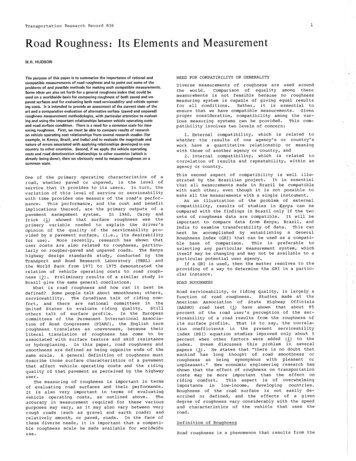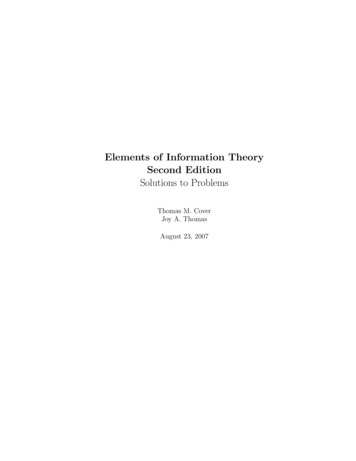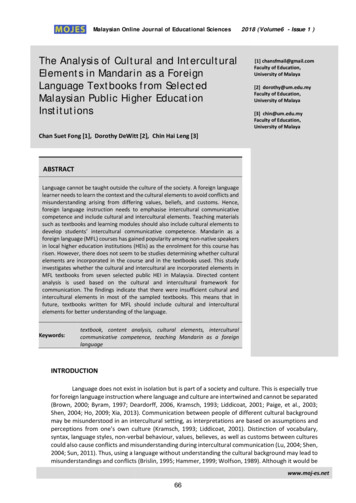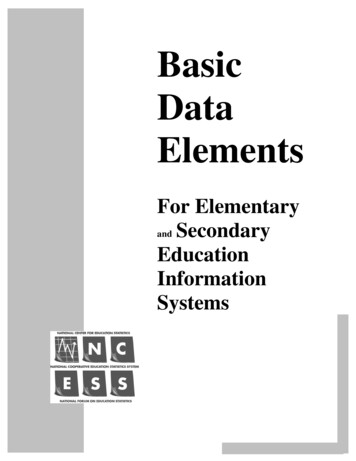
Transcription
BasicDataElementsFor Elementaryand SecondaryEducationInformationSystems
BasicDataElementsFor Elementaryand SecondaryEducationInformationSystemsJune 1997National Forum on Education StatisticsFor sale by the U.S. Government Printing, OfficeSuperintendent of Documents, Mall Stop- SSOP, Washington, DC 20402-9328ISBN 0-16-049139-8
U.S. Department of EducationRichard W. RileySecretaryOffice of Educational Research and ImprovementRamon C. CortinesActing Assistant SecretaryNational Center for Education StatisticsPascal D. Forgione, Jr.CommissionerThe National Center for Education Statistics (NCES) is the primary federal entity for collecting, analyzing,and reporting data related to education in the United States and other nations. It fulfills a congressionalmandate to collect, collate, analyze, and report full and complete statistics on the condition of education inthe United States; conduct and publish reports and specialized analyses of the meaning and significanceof such statistics; assist state and local education agencies in improving their statistical systems; andreview and report on education activities in foreign countries.NCES activities are designed to address high priority education data needs; provide consistent, reliable,complete, and accurate indicators of education status and trends; and report timely, useful, and highquality data to the U.S. Department of Education, the Congress, the states, other education policymakers,practitioners, data users, and the general public.We strive to make our products available in a variety of formats and in language that is appropriate to avariety of audiences. You, as our customer, are the best judge of our success in communicatinginformation effectively. If you have any comments or suggestions about this or any other NCES product orreport, we would like to hear from you. Please direct your comments to:National Center for Education StatisticsOffice of Educational Research and ImprovementU.S. Department of Education555 New Jersey Avenue NWWashington, DC 20208-5574June 1997The NCES World Wide Web Home Page ishttp://www.ed.gov/NCES/Suggested CitationU.S. Department of Education. National Center for Education Statistics. Basic Data Elements: ForElementary and Secondary Education Information Systems, NCES 97-531, by the National Forum onEducation Statistics. Washington, DC: 1997.Contact:Carol Sue Fromboluti(202) 219-1672Lee Hoffman(202) 219-1621
ForewordThis document represents a collaborative effort of representatives of education agenciesand associations at the local, state, and national levels who participate in the National Forum onEducation Statistics. The Forum was initiated in response to the Hawkins-Stafford EducationImprovement Amendments (Public Law 100-297) which established the National CooperativeEducation Statistics System. The Cooperative System was created in 1988 to respond toCongress’ desire to create a mechanism for states and the federal government to work together toproduce comparable and uniform education statistics for policymaking at all levels ofgovernment. The Forum’s mission is to develop and recommend strategies for strengthening avoluntary national education data system—one that fosters cooperation among existing local,state, and federal systems—to support the improvement of public and private educationthroughout the United States.Early in its existence, the Forum developed a strategic plan. One of the major goalsdescribed in the plan is:“to develop a comprehensive core system of comparable local, state, and federal datauseful to policymakers and educators at all levels of government. The Forum willidentify and define the core data needed to operate schools and districts, to supportstate and federal program reports, and to guide education policy at all levels.”It was hoped that core data would be able to answer policy and program questions withmaximum efficiency and minimal extra burden on respondents.In 1994, the Forum’s National Education Statistics Agenda Committee established a taskforce to identify a comprehensive and dynamic core of data elements based on clearly-definedcriteria that meets the requirements specified in the goal stated above. This report contains therecommendations of the task force for a set of basic data elements that provides the informationneeded to operate schools and districts, support state and federal program reporting, and guideeducation policy at all levels. Contained in this report is a set of student and staff level dataelements. Areas such as school finance and facilities are not addressed in this report. Additionalwork will be done to identify data elements in these areas. In addition, the task force willcontinue additional review of federal reporting data elements, taking into account the changingdata requests from the federal government. While this report does capture many of the dataelements needed for state and federal reporting, state and local data collectors still need toexamine and incorporate those data elements that are critical for state and local reportingpurposes.iii
Also contained in this report is a recommended process for identifying and periodicallyupdating the set of data elements to be maintained by a school, school district, state educationagency, or other education unit with a need for student and staff information.This set of basic data elements does not include data elements more typically collected insample surveys or those reflecting unique local and state activities. The purpose of these basicdata elements is to provide a common language to promote the collection and reporting ofcomparable education data to guide policy and assist in the administration of state and localeducation systems.iv
AcknowledgmentsLeadership for this project was provided by a task force consisting of representatives fromstate, regional, and national education agencies and associations. The persons who served on thetask force for one or more years include Thomas Soltys (Delaware), Chair from April 1994 toApril 1995; Dori Nielson (Montana), Chair beginning in May 1995; Ken Adler (Wisconsin);Matthew Cohen (Ohio); Lynn Cornett (Southern Regional Education Board, Atlanta, Georgia);Lavan Dukes (Florida); Gary Farland (Minnesota); Hal Robins (Utah); Ed Sloat (Arizona); andJudith Thompson (Connecticut). Participating from the National Center for Education Statisticswere Carol Sue Fromboluti, Lee Hoffman and Mary Rollefson. Providing assistance to the taskforce were Barbara Clements, Carol Lam, and Tom Szuba of the Council of Chief State SchoolOfficers.The task force is indebted to the numerous local, state, and national education agency andprofessional organization representatives who served on focus groups, reviewed the draftdocuments, and participated in round table discussions. Their comments on the feasibility ofimplementing such a set of basic data elements are especially appreciated.v
Table of ContentsForeword .iiiAcknowledgments. vSection IExecutive Summary.I-1Section IIIntroduction. II-1The Role of the Basic Data Elements . II-2Definitions of Data Elements and Indicators. II-3The Selection of the Basic Data Elements. II-3Contents of This Report. II-5Section IIIA Process for Selecting Basic Data Elements . III-1Step 1: Identify Information Needs. III-1Step 2: Identify and Define Data Elements That Generate the InformationNeeded . III-3Step 3: Examine the Quality of Data Elements Using the Six SelectionCriteria . III-3Step 4: Check the Efficiency of the Collective Body of Data Elements. III-3Step 5: Update Periodically the Set of Data Elements to Reflect Changesin Information Needs such as Reporting Requirements orEducation Goals-Conditions. III-3Section IVImplementing the Basic Data Elements .IV-11. Adopt the Process for Selecting Basic Data Elements.IV-12. Incorporate the Process into All Data Planning and DevelopmentActivities .IV- 13. Use the Contents of This Report To Encourage Schools andDistricts To Provide Better Quality Data .IV-24. Provide Training and Support for Schools and Districts To Usethe Contents of This Report .IV-25. Advertise Compelling Reasons for Districts and Schools To UseThis Report.IV-26. Work With State and Local Software Vendors To Incorporatethe Basic Data Elements and Their Definitions .IV-3Conclusion .IV-3vii
Section VBasic Data Elements for Student Information Systems . V-1Considerations When Selecting Data Elements. V-1Student Data Elements. V-2Basic Data Elements for Student Information Systems. V-3Definitions of Basic Data Elements for Student Information Systems . V-11Entity Uses. V-11Student Data Elements. V-12AttachmentsV-(1) List of U S. States and Extra-State Jurisdictions and Codes . V-(1)-1V-(2) List of Countries and Codes .V-(2)-lV-(3) List of Languages and Codes .V-(3)-lV-(4) List of Selected Programs Funded by the Federal Government .V-(4)-lSection VI Basic Data Elements for Staff Information Systems.VI-1Considerations When Selecting Data Elements.VI-1Staff Data Elements .VI-2Basic Data Elements for Staff Information Systems .VI-3Definitions of Basic Data Elements for Staff Information Systems.VI-9Entity Uses .VI-9Staff Data Elements.VI-10AttachmentsVI-(1) List of U S. States and Extra-State Jurisdictions and Codes .VI-(l)-1VI-(2) List of Regulated Occupations and Professions,except School Teachers .VI-(2)-lAppendix A Policy Questions, Indicators, and Basic Data Elements . A-1Exhibits, Figures, and TableFigure III-(A)A process for selecting basic data elements. III-2Exhibit III-(I)Criteria for evaluating the quality of data elements. III-4Figure IV-(A)A process for selecting basic data elements,illustrated with specific examples .IV-5Exhibit IV-(I)Criteria for evaluating the quality of data elements,illustrated with examples.IV-6Exhibit A-(I)Key Questions and Indicators in Four Major Domainsof Education Information . A-2Table AList of key questions, indicators, and constituentstudent-staff data elements . A-7viii
Section IExecutive Summary
Basic Data ElementsExecutive SummarySince the creation of the National Cooperative Educational Statistics System in 1988, stateshave joined with the National Center for Education Statistics to “produce and maintain .comparable and uniform education statistics.” Through the Cooperative’s guiding organization,the National Forum on Education Statistics, states have met to develop and propose a set of basicdata elements for voluntary use. Using these basic data elements will provide more comparableand reliable education information for any educational system adopting the commonterminology. It will also reduce redundancy and alleviate burden on data collectors andproviders.What Are The Basic Data Elements?The basic data elements are building blocks for an education information system. Theimplementation of these basic data elements can provide data for: education policy and decisionmaking for elementary and secondary education; the understanding, operation, management, and improvement of local and stateeducation systems and federal education programs; and comparable statistics at the school, district, state, and national levels.The basic data elements included in this report will not meet every education informationpurpose. Although this report captures many of the data elements that are needed for state andfederal reporting, additional review of federal reporting data elements will be continued by theForum on Education Statistics, taking into account the changing data requests from the federalgovernment. In addition, state and local data collectors must examine and incorporate those dataelements that are critical for state and local reporting purposes.Policy Questions, Indicators, and Basic Data ElementsHow well are our children learning? What is the cost of public education? Do allstudents have the same opportunities to study challenging subject matter? Do students in theU.S. learn as much as their counterparts in other countries?People who have tried to monitor the progress of students in their school systems orcompare their education systems with another know that simple answers are hard to find. Howdo we know the exact content covered in a course? Do the names given to staff positions indifferent parts of the country have enough consistency to know what they really do? Withvariations in terms, how can a district compare its students, staff, services, programs—not tomention its effectiveness-with those in another district?I-1
The most important use of this set of basic data elements is to help schools address theneeds of students. When these data elements are maintained at the school or district level theycan provide information for teachers to monitor student needs, parents to become aware of theirchildren’s performance and principals to make better decisions regarding their schools and toensure that students have qualified teachers and administrators. More comparable informationenables state and local government leaders and the public to gauge the effectiveness of schoolsand how education dollars are being spent.How To Use The Set of Basic Data ElementsA set of basic data elements should provide the means to answer the most frequently askedquestions about the administration, status, quality, operation and performance of schools andschool systems. But comparable, reliable, valid, measurable, and regularly collected data havenot been available to do so.This report is a first step to accomplish this task. The report contains a process for selecting and including new data elements into an information system,making it more comprehensive and dynamic; and student and staff data elements that can be used to create information for– conducting the day-to-day administration of schools and school districts;– completing federal and state reports; and– creating indicators that address questions about the success and functioning ofeducation systems.Future DirectionsThe information needs of education systems are constantly changing and educationinformation systems must be modified to meet those needs.This report contains a process for identifying the data needed to accommodate thesechanges. Using the established criteria, items can be added and deleted over time. Moreover,school systems can use the elements that are locally relevant and add their own items tocomplement the set. The intent of this report is to assist in data collection and to facilitate thesharing of information through commonly agreed upon definitions.I-2
Section IIIntroduction
Section IIIntroductionPolicy makers at all levels of the education system in the United States recognize the needfor comparable and complete information about public education. The lack of high quality data,described in A Nation at Risk in 1983, is even more critical in this era of reform and greaterschool accountability. The solution to our data needs must balance the desire for a greateramount of local flexibility and freedom from regulations with the need to accurately monitor theprogress of the students served with public funds. Governors, state legislators, other state andlocal policymakers, and the public want the capability to evaluate their schools by comparingthem to schools in other states and nations. Such comparisons, however, are problematic if theinformation is not collected using comparable definitions, procedures, and time schedules.In the United States, the public education system is decentralized. As a general rule,schools, school districts, and state education agencies collect education data for their ownplanning and operational needs. Most states do not share the same data requirements or systemsfor collecting and reporting data. In order for American education at all levels to operateeffectively and continue to improve, a coordinated data system comprised of comparable andcomprehensive information first must be established.In recent years, the leadership for identifying and promoting “best practices” in the area ofeducation data collection has come from the National Forum on Education Statistics, whichconsists of representatives from state education agencies, the U.S. Department of Education(especially the National Center for Education Statistics (NCES)), and professional educationassociations. The Forum, established by the National Center for Education Statistics in 1989 toassist with the implementation of Public Law 100-297 (the Hawkins-Stafford EducationImprovement Amendments), has established various task forces to focus on issues related to datapolicy and cooperative data improvement at all levels of education governance.This report presents the recommendations of one such task force. This document containsa set of recommended basic data elements that, if maintained at the school, district, and statelevels in a standard format, will inform key decisionmakers charged with the responsibility forensuring th
data elements is to provide a common language to promote the collection and reporting of comparable education data to guide policy and assist in the administration of state and local education systems. v Ackn

